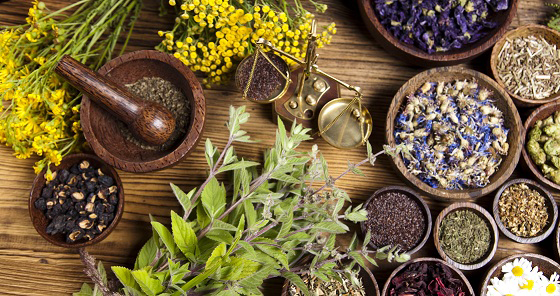 Herbal medicine has been used as far back as
records were kept to aid in the healing of illness. Even if
you don't believe in the healing power of herbs, I'll bet that
you have ten to fifteen medicinal herbs in your house right
now. All culinary herbs and spices are medicinal. In fact,
to our ancient ancestors, their flavor enhancement properties
were incidental to their primary uses: food preservation
and medicine. We have depended on plants since
the beginning of time both as a food source and a remedy
to what ails us.
Herbal medicine has been used as far back as
records were kept to aid in the healing of illness. Even if
you don't believe in the healing power of herbs, I'll bet that
you have ten to fifteen medicinal herbs in your house right
now. All culinary herbs and spices are medicinal. In fact,
to our ancient ancestors, their flavor enhancement properties
were incidental to their primary uses: food preservation
and medicine. We have depended on plants since
the beginning of time both as a food source and a remedy
to what ails us.
From the ancient times and sadly, even into the present day, while male physicians doctored the rich and royal and wrote all of the classic texts, herbalists, generally women, took care of everyone else. Women healers have been known by many names: midwives, wise women, green women, witch, old wives, and nurses. That prejudice still abounds today. Just ask your medical doctor if he thinks peppermint will calm an upset stomach. Physicians and researchers dismiss herbal medical wisdom as "old wives' tales." But if you dare to try out these tales, you will find why they have remained a part of our spoken heritage for so long. They work.
Society's viewpoint of herbal medicine has changed greatly over the years, from the down swing of seeing herbal medicine as total fakery to the up swing we are currently in of viewing herbalism as having a cure for every ailment. In most shopping centers you will find a herbal/health food store. At your local grocery store, at the convenience market you frequent, even on eBay; herbs are all around us, as is the pervasive general knowledge of what simple remedies herbs can offer. The World Health Organization (WHO) estimates that 4 billion people, 80 percent of the world population, presently use herbal medicine for some aspect of primary healthcare.
Here are some basic herbs and their uses:
Lavender: Relaxes the central nervous system. Contains antibacterial properties. Historically used by Romans in the laundry.
Garlic: Antibacterial, anti-fungal, antiviral, and hypotensive (lowers blood pressure) properties. Lowers cholesterol and fat in the bloodstream.
Aloe Vera: Internally this is an excellent laxative. Externally an unsurpassed healer of broken skin.
Thyme: Powerful antiseptic herb and also is antispasmodic and an astringent. Makes a nice face rinse.
Rosemary: Strong antioxidant, used to treat headaches and stomach upset. Do NOT take if pregnant, most likely will cause miscarriage.
Echinacea: Strengthens immune system. The leaf and root have antibacterial and antiviral properties. Also used for wound healing.
Clove: An aphrodisiac. Also has antiseptic and anti-emetic (anti-nausea) properties. A powerful pain-reliever. Historically used as a meat preservative.
Red Raspberry: Strengthens the tissue of the uterus in preparation for labor where it will assist contractions. Additionally tones all female organs.
The future of herbal medicine is unclear. Under current Food and Drug Administration regulations, herbal medicines inhabit a regulatory limbo. They are classified as "dietary supplements," and therefore not regulated, but many people think they should be regulated at least as over-the-counter-drugs. Herbs are among the lowest risk treatments in the world. When released to general populations, herbal treatments for particular diseases have been shown to be both safer and more effective than their chemically produced pharmaceutical counterparts. Regardless of the legal entanglements, herbal medicine is here to stay. According to a national telephone survey conducted by Prevention Magazine, herbal alternatives have become mainstream. The survey showed that one third of the nation's adults (32 percent) spent an average of $54 per year on herbal remedies to treat more common health conditions. That's almost 60 million people who rely on herbs and herbal medicine to ease their diseases. Even the doctors are jumping onto the bandwagon. Harvard, Stanton, and John-Hopkins, all world-renowned medical schools, now offer classes that teach the basis of herbal medicine. It seems that what was old is new once again.
Originally published in Acrimony Magazine Issue #4 November 2003











